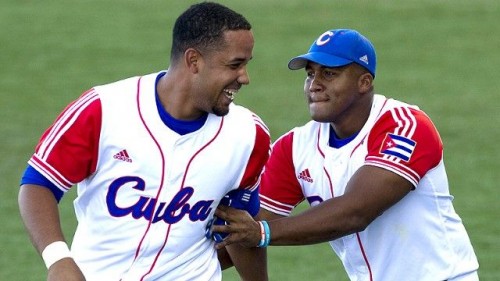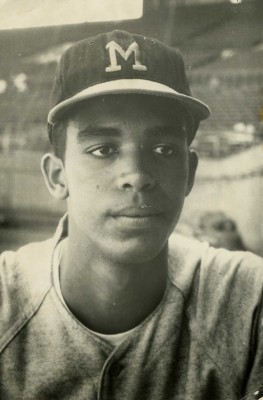 I would like to share to many details into Cuban baseball history, which is an excerpt of my senior thesis. I hope you enjoy. This will be an ongoing feature with different countries, and will have a surprise interview at the end.
I would like to share to many details into Cuban baseball history, which is an excerpt of my senior thesis. I hope you enjoy. This will be an ongoing feature with different countries, and will have a surprise interview at the end.
There is no question about where the root of Caribbean Baseball was as it started in Cuba, but the stories of how it got there are very different from person to person. According to Viva Baseball, a documentary created by the Spike Channel about Latin American players, upper class White Cuban students who had been studying in America, learned about the sport from Americans around the time of the Civil War. According to Viva Baseball, they brought it back and taught it to others.
Another story, according to Kurlansky, told of American influence directly onto Cuban Baseball when the embargo ended in 1814 with Spanish controlled Cuba. During that time trade was happening between the United States, and Cuba, so with the trade came Baseball in the 1860’s.
What both sources agree on was why baseball was cemented as the Cuban pastime. The sport was a form of defiance by the Cubans against the Spanish, by using their economic opposition’s pastime, America against the Spanish. It was an easy choice, according to Viva Baseball, considering many Cubans were not fond of soccer, Spgymain’s pastime. Soon after being introduced, many different amateur teams started to sprout up all over the countryside. American influence was a large reason for Baseball spreading, not just to Cuba, but to each Latin American country in general, and it wasn’t just by how the United States asserted itself into countries, but also by the sugar trade.
Sugar started booming in the 1860’s in Cuba. Baseball boomed with it. Cuba was a large host to the sugar trade, and at that time became one of the largest export of sugar in the world The sugar trade summoned foreign sugar cane workers called Cocolos from different islands around Cuba, who played the sport in their scarce, yet valued break time. Entrepreneurs then spread the sport through their own businesses to places such as Venezuela and the Dominican Republic.
Cuba’s league started to gain fame to American players. At times in the early 1900’s, American teams like the Cincinnati Reds came down to play in warm-up games. The Cuban teams started to become very good, and were noticed for their talent, especially when pitcher José Méndez kept the Reds from scoring a run for 25 innings in 3 games.
Yankees legend Babe Ruth, after a warm-up match was so impressed, that he believed if they signed some of these Cuban players, the team would likely run away with the division by June. So some American teams started to sign White Cuban players. Armando Marsans and Rafael Almeida debuted together as the first two Latin American players in the Major Leagues in 1911 with the Cincinnati Reds.
 While Cuban whites were allowed to play, darker players in Cuba had to stay in their leagues until Jackie Robinson and Branch Rickey broke the Color Barrier, or go to others such as the Mexican, Puerto Rican, Dominican, Venezuelan, and Negro Leagues in the United States. Had it not been for racism, players such as Martin Dihigo would have had a place among High American Baseball Honors.
While Cuban whites were allowed to play, darker players in Cuba had to stay in their leagues until Jackie Robinson and Branch Rickey broke the Color Barrier, or go to others such as the Mexican, Puerto Rican, Dominican, Venezuelan, and Negro Leagues in the United States. Had it not been for racism, players such as Martin Dihigo would have had a place among High American Baseball Honors.
Dihigo was a wonderful example of how American Baseball would have progressed earlier if not for racism. He was a dark-skinned Cuban, who had played every single position, and really just dominated. To many, he was well revered as a legend for Cuba, and went and played in many leagues that weren’t the Majors, such as the Mexican, Venezuelan, and American Negro Leagues. He was famous in every league, pitching first no-hit game in the Mexican League, and competing for the Triple Crown, year after year with Josh Gibson, who was said to be the Black Babe Ruth (Or some say, even better). In the Mexican, Venezuelan, Cuban, and Negro Leagues, he entered the Hall of Fame.
The Washington Senators really started the first mass-signings of White Cuban players in the mid 1930’s. Clark Griffith, who was owner of the team, hired scout Joe Cambria, to start bringing in new talent to their team. While the team was an utter disaster, aside from legendary pitcher Walter Johnson, they did provide a new bridge into Latin America. “Papa” Joe Cambria found a way to stroll the Cuban sugar fields, and nearly kidnap Cuban players, by signing them to incredibly cheap bonuses and sending them to Washington to compete.
After Robinson and Rickey broke the color barrier in 1947, blacker players came in to the mix from Latin America. Although Rickey wanted to integrate first into Brooklyn, he could not find a Latin Ballplayer with a demeanor that would endure racism the way Jackie Robinson did. Rickey integrated the Major Leagues with players who weren’t the best in their leagues, but people say he was certain could endure hardship. In Jackie Robinson’s recent biopic 42, Rickey exclaimed he wanted a player “with the guts not to fight back.” The players he chose who were Latino, were more high-strung than the black players.
Minnie Minoso, however, was not. In 1951, Minoso broke the Black-Latino color barrier with the Chicago White Sox, which started the floodgate of many Latin American stars coming in. No one, however believed that this would have been done without help from Robinson and Rickey four years before. However, Minoso endured more than Robinson, not just for color, but because he was Latin as well. But, while Cubans like Minnie Minoso and RHP Luis Tiant pioneered Latin-black integration, Cuban recognition was then suddenly shut out by politics when Fidel Castro came to power and an embargo happened between the United States and Cuba in 1960.
What was worse for the Cuban and United States’ embargo was that the most prominent winter leagues were played in Cuba. So America then moved to the Dominican Republic, Mexico, and Venezuela to continue to play in the hot sun with some fierce competition. Cuban baseball, however, never exactly diminished on the Island because of being cut off from American leagues, and still boasts the best talents. Many stars from Cuba, seeking better bonuses than what the island had to offer, defected from Cuba to sign large team deals with Major League teams. Jose Abreu is one of the newest examples of Cuban talent, signing with the White Sox for 4 years, and $64 Million Dollars.

Being one of those white Cubans who left in 62 I can tell you the story of the history of baseball in Cuba.When baseball was first invented in Harvard their was a Cuban stundent there who brought it back to Cuba thereby having Cuban baseball start in the same time as in America,we have had as long a history in the game as here,we where there when it was invented.These facts are confirmed in various Cuban history books which I have read trying to learn the history of my country of birth.As I kid of six years old I came when I was five I watch the first Met grand slam on TV and I was hooked into being a Met fan and started going to Shea living in queens since it’s inception.My love of scouting and following developed because I couldn’t firgure out why the guy that started me on the game just got a cup of coffe and was never heard again,his name was Rod Kanehl,I felt I was part of the growing Met history .When we got a new stadium I was hooked and though Shea was my home away from home.Me and my friend used to sneak into the stadium and I believe I meet Omar Minaya ther doing the same thing with us one game.We meet Seaver in the tunnel and my friend ask him if he though he had a shot at rookie of the year,the rest is history.My only regret is my family moved to Dallas for six months in 69 and I missed the celebration on the field that year.Being a kid I had no choice but I’m happy to say I enjoyed every second of the 86 celebrations.I remember going crazy when we got Gary Carter.Growing up in Astoria Queens and the inception of the Mets being a Met fan was a no brainer.I have yet not gone to Citifield and I really miss it but I refuse to feed the ownership without a commitment to winning and if they can’t offord it selll and get someone who will spend not like the Yankees but a decent amount that reflects a NY franchise.
My typing skills are terrible ,excuse me for my failures in typing out my comments.
Rene, your modesty is appreciated as the typing is just fine. I wish you could have written more about growing up a Mets fan in the 60’s, how you feel when you see Cuban players coming over here and what the family left behind goes through, and whether Cuba would have any interest in maybe becoming an affiliate of MLB, like a minor league to gain the economic strength that would be associated.
Great stuff Rene, thank you.
Teddy, I responded to this post on MMO last week, but to reiterate it’s a topic that will no doubt give us mainland fans a small picture of how baseball is interwoven into those countries fabric. Looking forward to it all.
Rene, amazing and fascinating. I really appreciate your side of the story.
I hope to not offend you with the hope of reopening Cuba. The talent of Cuba is understated, and will continue in a great development of players similar to what I will explain later with the Dominican Republic.
I especially hope you have appreciated my writing of your baseball history, and thank you for reading.
Rene I am also A Cuban born American I came here in the summer of 1961 and have been a Met fan since their inception into the league. I was born in Santiago de Cuba and grew up in Mayari near by. Nice to have read your comments my brother take care and maybe soon we will see some winning from our team again.